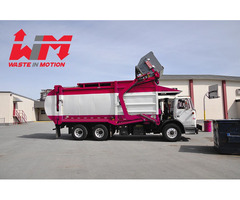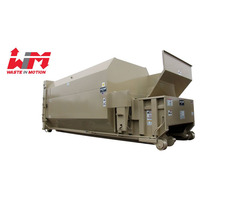Dynamic Compactor Monitoring
Waste in Motions Dynamic Compactor Monitoring system can help owners optimize their haul tonnages. DCM tells you whether the compactor is full or not, and eliminates false full indications. It will also automatically dispatch a truck to service your compactor before you fill up. Read on to learn more!
Compactors are used where a client generates a continuous high volume of relatively low density material, and seeks to maximize the tonnage being hauled per trip. Shopping malls, manufacturers, hotels and hospitals are typical users of this type of waste handling equipment.
How Waste Compactors Operate
In general, compactors are either a self contained all-in-one unit or a detachable receiver type, where the waste bin is removed from the compactor section and hauled to the landfill. Each has their own advantages. Typical hopper sizes are 20 to 30 cubic yards, with an overall length between 20 and 24 feet.
Compactors reduce the number of pickups required by reducing the volume of waste and eliminating air pockets, thus increasing the density of the material. They can utilize a hydraulic ram to crush and push material, or they may be outfitted with an auger style system. Compactors also have a side benefit of keeping the waste area cleaner, by not having material pile up in an open bin.
Compactors also require dedicated electrical connections to operate, most commonly 3 phase power. With proper maintenance, they have a long lifespan, but need an intial upfront capital investment for the purchase cost and installation.
A compactors action is a bit like stuffing a sleeping bag into the carrying bag you mount on your rucksack. Your sleeping bag takes up a lot of volume, but stuff it into the small bag and you save space. A compactor performs the same function by having a hydraulic ram shove and compress waste towards the front.
As the bottom waste is pushed forward, it reaches the front wall. This material has nowhere to expand other than upwards into empty space. The expanding material tends to rise up and curl back over itself towards the rear (think of a wave crashing but in reverse).
Through a continuous packing motion, the compactor will eventually eliminate air pockets and raise the density of the material. This is how you unlock the most important function of effective compactor management; maximizing the payload per haul.
Mistakes When Trying to Manage Compactors
Maximizing the payload per haul requires monitoring of the compactors. Sometimes an employee will conduct spot checks by looking at the compactor full gauge. But its not really practical to have an employee stand all day by the compactor, tracking the volume that goes into it. Thus, a common practice is to take an educated guess on service needs based on historical assumptions, and schedule pickups based on that. Occasional monitoring may indicate that the compactor is filling up faster than normal, in which case an extra or emergency service will be ordered, incurring additional hauling charges.
The problem with this approach to compactor monitoring is that it tends to erode the benefits of using a compactor in the first place. Set schedules can help prevent a compactor from being unusable because its full, but the cost is an increase in hauling expenses and lowered payload tonnages per trip. Things becomes especially challenging if the waste stream volume fluctuates; your compactor could be full at 11 in the morning or 11 at night. Checking the compactor full gauge manually means you are REACTING to the volume in the container, versus PROACTIVE monitoring and scheduling of hauls.
Compactor Bridging
Bridging is another phenomenon that is easier shown than explained, but think of it this way. Bridging occurs when the waste being compacted forward jams on itself and doesnt allow the waste to expand up and backwards to fill the voids. A bridge of hard compacted material thus forms between the ram and the front of the compactor. This can lead to higher hydraulic pressures, thus indicating a full unit, when in fact it might only be at 50% capacity. A bridging scenario can usually be solved through repeated cycling of the compactor, but you have to know thats it is actually happening in the first case. It is common for a bridging scenario to indicate a full compactor (false full) situation, even though the unit is actually not full.
Compactor Optimization Solutions
We have the solution to solve these challenges: Dynamic Compactor Monitoring (DCM)
Waste in Motion has partnered with a leader in compactor monitoring equipment to offer this unique management solution for our clients. Dynamic Compactor Monitoring is a Green Technology Solution that will MAXIMIZE your compactor utilization while reducing the number of hauls! By providing real time monitoring of your compactor operations, WIM can:
reduce your carbon footprint
optimize your compactor utilization
maximize your payload weights per haulout
eliminate unnecessary pickups, and
SAVE YOU MONEY!
Best of all, DCM does not require modifications to the compactor unit that could void a manufacturers warranty.
How Does Dynamic Compactor Monitoring Work?
A compact DCM unit is installed beside the compactor, most commonly inside near the control panel
The DCM unit monitors amperage loads on the electronic motors
Your compactor is remote live monitored 24 hours per day
Analytic software compiles data each time your unit is cycled
Analysts review the reported data sent to the server daily
False full or bridging scenarios are avoided by watching the data sent by a compactor
At the appropriate time a decision to service your compactor is made
The hauler is notified by phone or email 24 hours in advance to service the compactor
The Customer also receives notice of service
Your unit is emptied, and your operations continue uninterrupted
Dynamic Compactor Monitoring Will:
Deliver a real world, tangible Green solution
Reduce your carbon footprint
Provide an immediate Return on Investment
Minimize the number of hauls
Maximize compactor tonnages
Identify Bridging scenarios, and give clients solution advice
Automatically dispatch a pickup ahead of time
Track your individual compactor data over time to identify trends
Provide meaningful KPIs and Metrics
Not require modification of the compactor equipment
We have service plans and options available to minimize or even eliminate the capital investment required!
Be a COST SAVINGS HERO!
Call Waste in Motion at 1 (587) 355-7242 and lets start putting money back into your pocket!








 Loading
Loading






